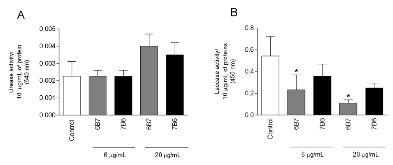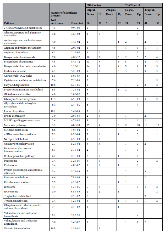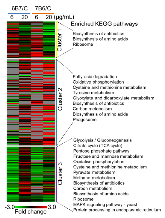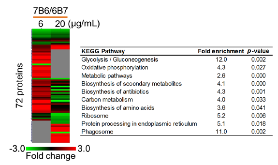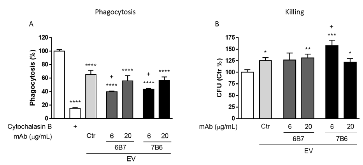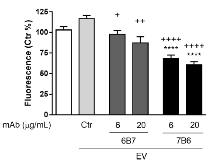Concentration-dependent protein loading of extracellular vesicles released by Histoplasma capsulatum after antibody treatment and its modulatory action upon macrophages
- Albert Einstein College of Medicine, Bronx, NY (United States); Univ. Federal de Minas Gerais, Minas Gerais (Brazil)
- Albert Einstein College of Medicine, Bronx, NY (United States)
- Pacific Northwest National Lab. (PNNL), Richland, WA (United States)
- National Univ. of Singapore (Singapore)
- Univ. Federal do Rio de Janeiro (UFRJ), Rio de Janeiro (Brazil)
Here, diverse pathogenic fungi secrete extracellular vesicles (EV) that contain macromolecules, including virulence factors that can modulate the host immune response. We recently demonstrated that the binding of monoclonal antibodies (mAb) modulates how Histoplasma capsulatum load and releases its extracellular vesicles (EV). In the present paper, we addressed a concentration-dependent impact on the fungus’ EV loading and release with different mAb, as well as the pathophysiological role of these EV during the host-pathogen interaction. We found that the mAbs differentially regulate EV content in concentration-dependent and independent manners. Enzymatic assays demonstrated that laccase activity in EV from H. capsulatum opsonized with 6B7 was reduced, but urease activity was not altered. The uptake of H. capsulatum by macrophages pre-treated with EV, presented an antibody concentration-dependent phenotype. The intracellular killing of yeast cells was potently inhibited in macrophages pre-treated with EV from 7B6 (non-protective) mAb-opsonized H. capsulatum and this inhibition was associated with a decrease in the reactive-oxygen species generated by these macrophages. In summary, our findings show that opsonization quantitatively and qualitatively modifies H. capsulatum EV load and secretion leading to distinct effects on the host’s immune effector mechanisms, supporting the hypothesis that EV sorting and secretion are dynamic mechanisms for a fine-tuned response by fungal cells.
- Research Organization:
- Pacific Northwest National Laboratory (PNNL), Richland, WA (United States)
- Sponsoring Organization:
- USDOE
- Grant/Contract Number:
- AC05-76RL01830
- OSTI ID:
- 1441220
- Report Number(s):
- PNNL-SA-124828; PII: 25665
- Journal Information:
- Scientific Reports, Vol. 8, Issue 1; ISSN 2045-2322
- Publisher:
- Nature Publishing GroupCopyright Statement
- Country of Publication:
- United States
- Language:
- English
Web of Science
A Novel Protocol for the Isolation of Fungal Extracellular Vesicles Reveals the Participation of a Putative Scramblase in Polysaccharide Export and Capsule Construction in Cryptococcus gattii
|
journal | March 2019 |
Extracellular Vesicle-Mediated RNA Release in Histoplasma capsulatum
|
journal | March 2019 |
Fungal Extracellular Vesicles as Potential Targets for Immune Interventions
|
journal | October 2019 |
Similar Records
Media matters! Alterations in the loading and release of Histoplasma capsulatum extracellular vesicles in response to different nutritional milieus
Remodeling of the Histoplasma Capsulatum Membrane Induced by Monoclonal Antibodies

